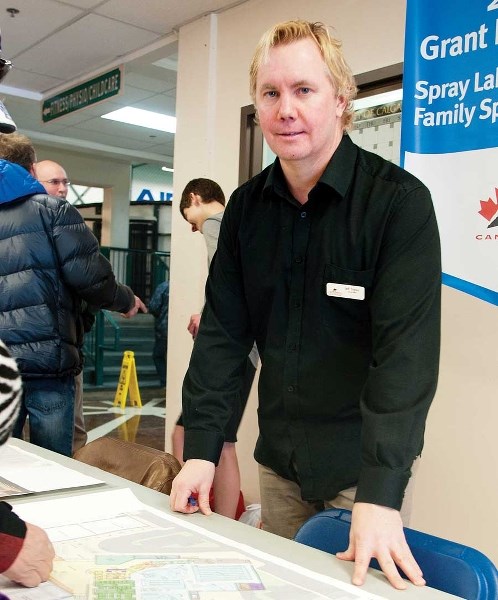The proposed aquatic centre/curling facility is moving into the next phase, following a Jan. 27 reveal of the new schematic design to council, shaving around 4,600 square feet and $9 million off the cost for a total price tag of $45 million.
Councilor Jeff Toews set up at the Spray Lake Sawmills (SLS) Family Sports Centre Feb. 8 from 1-3 p.m., with copies of the new schematic design in hand and answering questions to passersbys.
Mayor Ivan Brooker flew to Ottawa to meet with Wild Rose MP Blake Richards Jan. 29, mainly to review Cochrane’s 10-Year Financial Strategy and to make it clear that Cochrane would be ‘shovel-ready’ with respect to the proposed facility, to apply for any possible grants.
“Up until this point, there has been a lot of talk, but now it can become an action item,” said Brooker. “By the end of March we expect to have detailed drawings with exact costs and will kick our fundraising into high gear.”
This would include a potential Building Canada Grant (an estimated $3 million in federal monies, matched by $3 million in provincial dollars); an announcement on the 2014 grant will be sometime in March.
But not everyone is sold on the price tag or in support of a new curling club of this proportion.
Cochranite Jim Uffelmann, who ran for council in the 2013 election, said he doesn’t want to see current council “go for the big Cadillac system and wind up with nothing”.
“I’m concerned with the price tag,” said Uffelmann. “How did we wrap the curling centre into that without really gauging how the community felt?”
Uffelmann said he would be interested to see the numbers of cost per use from both current facilities (the pool and curling rink) amortized over a period of years, with capitol costs factored in; bottom line is that Uffelman said he feels the demand for a new curling club may not justify the cost of a new facility of this proportion.
Other concerns Uffelman addressed included the need for a 3,500 square foot lounge, the multi-use aspects of the aquatic centre itself and council’s aversion to approaching the project in phases.
“The project is being designed where we can phase the project if we need to,” explained Toews, adding that he is opposed to the project being phased in for three major reasons: construction costs are rising at four per cent annually; a phased project would cause disruption to current programming at the SLS Centre; and there is a $4 million cost savings by packaging the aquatic centre with the curling club.
Toews said he spoke with some 30 people at the SLS Centre last weekend. Overall, he felt the consensus on the schematic design to be positive.
“It was interesting because I talked to a lot of people who stopped by and weren’t from Cochrane,” said Toews, adding that a woman who sits on an aquatic centre committee from Lethbridge was very pleased with the cost-recovery plans.
For Toews, a number of factors justify the $45 million price tag, including the annual loss of $450-$500,000 for the current pool (with no leasable space or potential for cost recovery options); the growth of Cochrane (the proposed facility would be able to accommodate the town’s population for 25 years); and the cost-recovery design of the proposed facility would potentially see it self-sustainable after five years of opening.
Toews said that the proposed facility is estimated at a $700,000 annual loss, which he said would be greatly offset through the approximate 16,000 square feet of leasable space, as well as the implementation of a Thermanex system (which takes heat from areas of the building that don’t need it and moves it to areas that do) and is conservatively estimated at achieve a 30-40 per cent cost savings.
Toews said if the current curling club was operating at a marginal deficit, he was unaware of how much, as the club is designed to be self-sufficient.
Morgan Nagel was the sole councillor who voted against the $45 million project. Not unlike Uffelmann, Nagel’s concerns include the size of the project and the potential cost to the taxpayer.
“The reason I voted no was because I went over the numbers,” explained Nagel. “I’m afraid this council approved this (prematurely) before our strategic planning session on March 1.”
According to Nagel, the breakdown includes: $21.2 million from the Town of Cochrane (of this, $16.3 million from MSI grants, $4.2 million from community-enhanced levies and the remainder would be topped up from land sales); Rocky View County has so far committed to $2.2 million.
An outside consultant was brought in last year, estimating that Cochrane could potentially fundraise $6-$9 million. The potential Building Canada Grant could add another $6 million to the pot.
Nagel said this leaves a gap of $6-$10 million and would drive other town projects, including the new RCMP station, to be debt financed.
The councillor said from a fiscal standpoint, he would be more in favour of a phased-in project and still questions the need for a new curling club, referring to an overall decline in the sport as well as the new curling facility in Springbank (20 minutes from Cochrane).
Toews said he has spoken to Calgary curling clubs that disagree the popularity for the sport is declining.
Suzanne Gaida, senior manager of community services for the town, said this is the time for Cochrane businesses and private sponsors to get behind the project. The build-out of the proposed facility would include an additional 557 parking stalls. Toews added that this would not have an impact on the bordering off-leash dog park.
Construction of the proposed facility is estimated to take 18 months, once started in early 2015.




